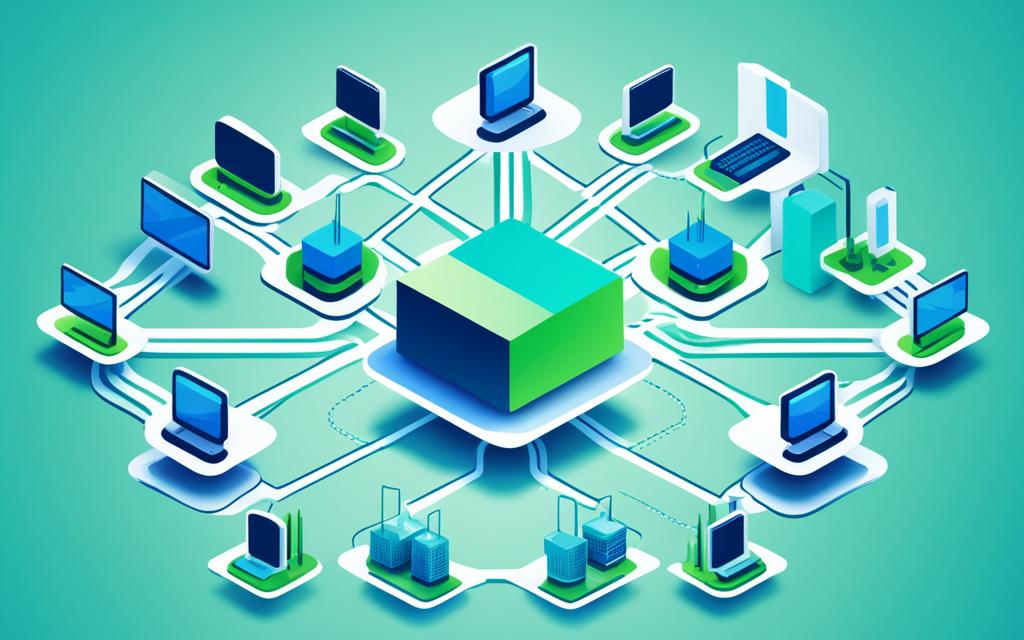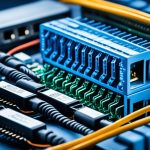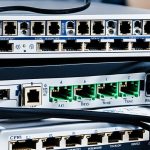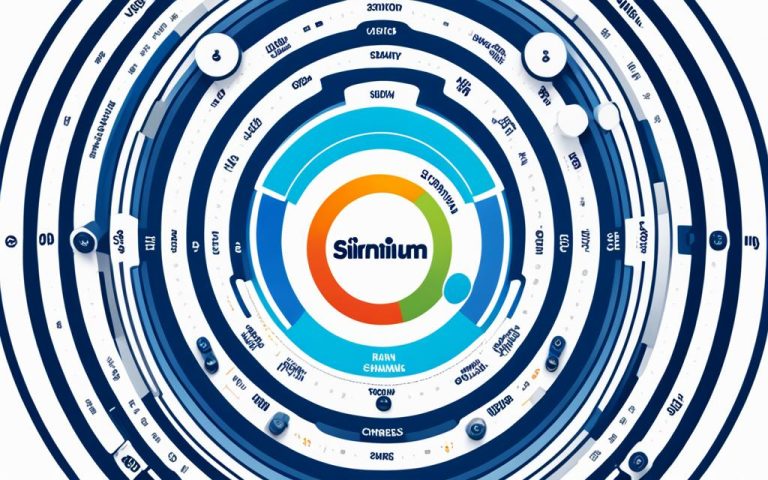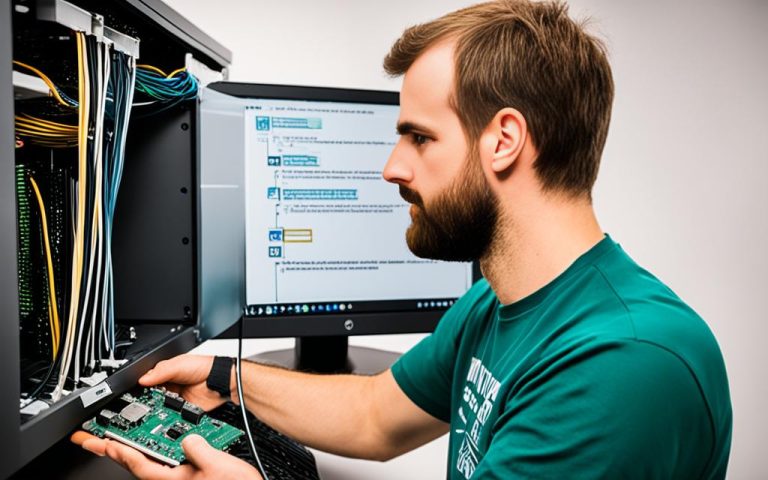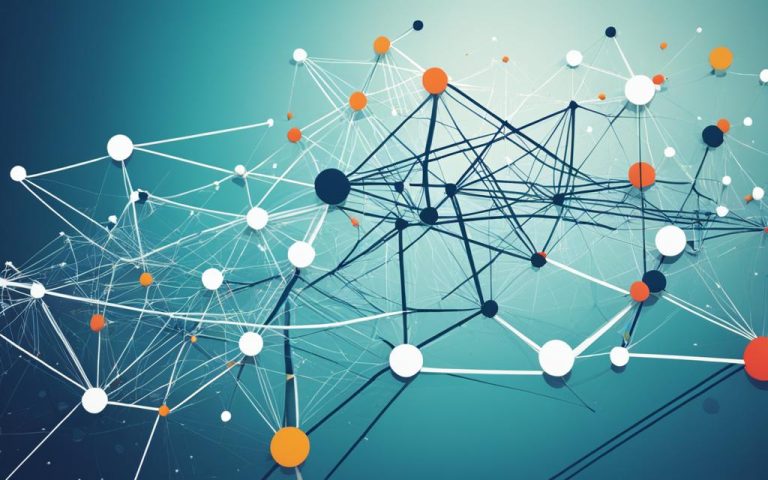Welcome to the world of data networks, where everything connects smoothly and talks efficiently. These networks are key for sharing info and working together in many places. Learning about data networks can change how you connect at work and in your life.
Private data networks help share info inside a company, making it easier for different teams to work together1. Public networks are for both people and companies, giving access to certain parts of the network for a fee1.
There are many kinds of data networks for different needs. PANs connect devices in a personal area1. LANs link devices in a small area, like an office, using special devices1. MANs cover bigger areas, like several buildings, and WANs reach over long distances, connecting many LANs1. Satellite networks send out data for many uses, and cellular networks make sure you can communicate without losing signal1.
Data networks send info using packet switching, breaking it into packets for better routing1. They also let data flow both ways, making sure messages get through clearly. This includes full-duplex for sending and receiving at the same time, and half-duplex for one way at a time1.
Key Takeaways:
- Data networks are the foundation of modern data communications, facilitating seamless connectivity and efficient communication.
- Private and public data networks serve specific purposes, catering to single organizations or multiple users.
- PANs, LANs, MANs, and WANs cover a range of areas, from personal workspaces to large geographic distances.
- Satellite and cellular networks provide specialized services, while packet switching and duplex communication optimize data transmission.
Fundamentals of Modern Network Infrastructure
In today’s digital world, having a strong network is key for businesses and keeping people connected. The network is like the main road for data to move around. It has many parts that work together to send data fast and keep communication smooth.
Wired networks are a big part of this. They use Ethernet cables for fast data sharing between devices. These networks often sit on top of fiber optic cables, which send data even faster and more securely. This makes them great for big data needs2.
But, people want to move around freely, so hybrid networks are getting popular. These mix wired and wireless tech, giving you the best of both. You get the fast, secure data flow of wired networks and the easy, flexible use of wireless networks. This lets you stay connected anywhere in the network2.
Some devices are key to making data move well in a network. Routers send data between networks, letting many devices connect at once. They act like traffic cops, directing data where it needs to go2. Switches help by cutting down on network delays and helping devices talk to each other2.
Servers are important too, managing users, resources, and apps on a network. They keep data safe and share it, making apps and websites available to everyone2. Firewalls are also crucial, watching over network traffic to keep out unwanted visitors and threats2.
For businesses, investing in a good network is a must. As data grows and companies get bigger, a strong network is more important3. Companies that look ahead make sure their networks can handle lots of data without breaking down, keeping work flowing smoothly3.
Networks are key to running businesses well and keeping them safe from cyber threats. Keeping data safe is a top goal, and networks help by setting up security steps3. Devices in the network help stop and find attacks, protecting important data and assets3.
In summary, knowing about modern network infrastructure is vital for both businesses and people. A strong network means better connectivity, faster data sharing, and better security. As technology keeps getting better, so will our networks, changing how we connect and communicate online.
Importance of Modern Network Infrastructure
In today’s digital world, having a good network infrastructure is key for businesses. It’s essential for smooth IT operations. It helps with communication, teamwork, and keeping data safe.
Network infrastructure includes many hardware and software parts. These parts help information move around in an organization. Things like switches, routers, and firewalls keep the network safe and connected4.
Modern networks let people work from anywhere, without needing to be in the office. This makes work more flexible and productive4.
Businesses can manage their devices through the network. This means they can check if devices are working, update them, and share files easily. This makes managing devices simpler and more efficient4.
A strong network is vital for businesses that need to move lots of data. Without it, data can get stuck, causing delays or even system failures. This can really hurt a business’s bottom line. So, it’s important to have a network that works well and is reliable4.
Keeping the network running well and safely is also key. One way to do this is through micro-segmentation. This means breaking the network into smaller parts for better control and security. It helps stop data breaches and makes the network faster4.
When building a network, think about things like how often it’s available, how fast it is, how secure it is, and how easy it is to manage. The network should fit the business’s needs. It should always be up, fast enough for work, secure from hackers, and easy to run4.
Companies like VMware offer great solutions for networks. VMware NSX gives a full network setup from top to bottom. Tanzu Service Mesh helps with app connections, security, and insights. VMware Aria Operations for Networks helps keep networks and apps running smoothly. And VMware Aria Automation makes managing infrastructure easier through code4.
Key Components of Modern Network Infrastructure
| Component Type | Description |
|---|---|
| Networking Hardware Devices | Things like switches, routers, and firewalls that make sure the network is safe, connected, and moves data well. |
| Software-Defined Network Resources | Virtual versions of switches, routers, and load balancers that make the network faster and easier to manage. |
| Monitoring and Management Tools | Tools and software that help watch over, analyze, and manage the network for better performance and upkeep. |
In conclusion, having a modern and reliable network is crucial for businesses today. It makes sure communication is smooth, teamwork works well, and data is safe. By choosing the right tech and following best practices, businesses can build a strong network that supports their growth and needs4.
What are Data Networks?
Data networks are made for sending data between different places. They use switching, lines, and controls for efficient data transfer. These networks are key for communication and sharing information in many fields.
Data transmission is a big part of data networks. It’s about sending and getting data over a network. Data is turned into a format for sending and a reliable connection is made between the sender and receiver. This process is vital for data networks to work well.
Packet switching is a key method in data networks. It breaks data into small packets and sends them over a network. This way, it uses network resources well and sends data fast. At the end, the packets are put back together to get the original data. This makes sending data faster and more reliable than old methods.
Data Networks is a well-known name in the IT world. They offer affordable IT hardware and services5. Their team has over 20 years of experience in designing solutions for cloud computing, networking, and cybersecurity5. Clients like the Washington County Health Department have praised their service since 20205. They’ve also helped Vancouver Public Schools improve their technology5.
Data Networks is a big help in education, working with schools like Washington County Public Schools and others5. Their IT solutions are made for schools’ needs. They work with companies like Hallaton Environmental Linings and Ruff Roofers to help businesses manage their IT better5.
They offer more than just hardware and services. Their Managed IT Services help clients focus on growing and innovating, with reliable IT support5. Many sectors, including healthcare and education, trust Data Networks for their IT needs5.
Different Types of Data Networks within the Modern Infrastructure
Data networks are key in today’s world for smooth communication and data sharing. They come in two main types: private and public networks. Each type has its own role and meets different needs.
Private networks, or LANs, help organizations share data easily among employees and departments. This boosts teamwork and productivity [source]. They connect computers over short distances, usually in one building or nearby. LANs often use cables but can also work wirelessly through WLANs [source]. WLANs let devices connect without cables, making them more flexible.
Public networks reach beyond one organization and let users outside the group join in. WANs are a type of public network that links computers over long distances . They’re important for companies with many locations or those needing to connect over big distances.
There are other networks too, like CANs for universities or small businesses with several buildings. These networks help share resources within a small area. MANs cover cities or towns and connect many organizations and people together .
Some networks have special jobs. Satellite networks bring Internet and other services to remote places. SANs connect storage devices to servers for fast data sharing. System-area networks link servers for super-fast connections. POLANs use light signals to connect many users and devices. EPNs and VPNs are for businesses and let people work together securely over the Internet .
Types of Data Networks
| Data Network Type | Description |
|---|---|
| Local Area Network (LAN) | Connects devices within a limited geographical area, such as an office or home 6. |
| Wide Area Network (WAN) | Covers greater distances, such as across cities or countries, and is slower than a LAN 6. |
| Metropolitan Area Network (MAN) | Functions similarly to a LAN but spans a larger geographical area, like a city or region 6. |
| Personal Area Network (PAN) | Interconnects electronic devices within an individual’s personal workspace 7. |
| Wireless Local Area Network (WLAN) | Operates similarly to LANs but without the reliance on physical cables 8. |
| Storage-Area Network (SAN) | Connects shared storage devices to several servers without relying on LAN or WAN 8. |
| Campus Area Network (CAN) | Often found in universities, large school districts, or small businesses spread across several close buildings for resource sharing 8. |
| Enterprise Private Network (EPN) | Owned by businesses to securely connect various locations and share computer resources 8. |
| Virtual Private Network (VPN) | Extends a private network across the Internet, allowing users to access the network remotely 8. |
Benefits of Leveraging the Potential of Data Networks in Your Modern Infrastructure
Data networks bring many benefits to modern infrastructure. They make it easy for computers to talk to each other, letting you send files and emails quickly. This is key for business communication and helps teams work together well. In fact, 78% of small businesses say smooth communication is a big plus of having a network9.
These networks also make it easier for teams to work together, even if they’re not in the same place. Everyone can add to a project at the same time, making work more efficient. Using networks for sharing things like files and internet helps businesses work better, with a 72% boost in efficiency9.
Lastly, data networks let businesses share things without needing to be physically close. This means sharing things like storage and printers is easy. It helps businesses use their resources better, with 65% of small businesses seeing better decision-making and efficiency from sharing data9.
By using data networks, businesses get better communication, teamwork, and sharing of resources. This means they can do more, work better, and perform better overall. Data networks are key to modern businesses, making things run smoothly and helping them succeed in today’s connected world.
Benefits of Leveraging Data Networks
| Benefit | Statistical Data |
|---|---|
| Resource sharing | Benefits include resource sharing, ease of communication, collaborative work opportunities, central software storage, and controlled access to a central database10 |
| Communication | Data networks enable fast and seamless communication between linked computers9 |
| Collaboration | Data networks facilitate collaboration by allowing multiple users to work on the same project or document remotely9 |
Using data networks well can unlock the full potential of modern infrastructure. As technology gets better, data networks will be more important for innovation and success in many areas. It’s important for businesses to see the value in data networks and invest in strong networks to stay ahead in today’s connected world.
Circuit Switched and Packet Switched Data
There are two main ways to send data over networks: circuit switching and packet switching.
Circuit switching sets up a direct path for data to travel. It’s often used in phone systems, where it sends the whole message on a dedicated line11. This method has perks like quick data transfer, steady speed, and packets arriving in the right order11. But, it’s mainly for voice calls, which means it can waste resources and be costly11.
Packet switching chops data into smaller pieces and sends them without needing a special path. This is efficient because it doesn’t use up channels all the time and helps avoid losing data11. Yet, it might not work well for always-on apps, as it can lose packets in busy networks and lacks security11.
Circuit switching gives a direct path for messages, ensuring steady speed and low delay for things like voice and video12. Packet switching is better for saving money, growing with the network, and handling lots of data well12. But, it might be slower and lose packets if the network gets too full or has errors12.
Examples of circuit-switched networks are regular phone lines or the public phone network13. T1 or T3 lines also use circuit switching for a steady connection between two points13. Packet-switched networks, however, support different qualities of service and include things like DSL, cable, and wireless connections13.
Knowing the differences between circuit and packet switching helps in making networks that work well, are reliable, and save money1112.
IP Addresses in Data Networking
IP addresses are key in data networking, acting as unique IDs for devices on the Internet. They help devices talk to each other and move data around efficiently.
The Internet Protocol (IP) sets the rules for IP addresses, making sure data gets to where it needs to go.
Today, we use two main types of IP addresses: IPv4 and IPv6. IPv4 uses 32 bits and can give about 4.3 billion unique addresses14. But, as more devices connect, we’re running out of IPv4 addresses.
IPv6 came to the rescue with a 128-bit system, offering trillions of unique addresses15. This means a huge increase in address space.
IPv4 addresses look like four numbers separated by dots, like 192.168.0.1. They’re easy for people to read. IPv6 addresses, on the other hand, use a hex format with eight groups of four digits14.
Video streaming is getting more popular, and with it, the demand for IP addresses. Despite using UDP for live streams, most video streams still go through HTTPS14. This shows how important HTTPS is for secure data.
IP addresses can be public or private. Public ones are unique worldwide and for devices directly on the Internet. Private ones are for use in networks and can share a single public address with NAT14.
IPv6 is the next step, offering better routing, security, and support for different communications14. It’s designed to handle the growing number of devices online.
In short, IP addresses are crucial for networking, letting devices communicate and send data. IPv4 and IPv6 have their own strengths and address formats. Knowing about IP addresses is key to managing and securing networks today.
Network Hubs, Switches, and Routers
Network hubs, switches, and routers are key parts of today’s data networks. Each one has a vital role in helping communication, managing traffic, and sending data efficiently. Let’s look at what makes these devices important.
Network Hubs
Network hubs work at the physical layer (layer 1) of the OSI model. They connect network devices together. When data comes in through one port, hubs send it to all other ports. This way, all devices get the data at the same time.
But, this method can cause problems with performance and security. That’s why hubs are seen as the least smart and efficient compared to switches and routers16.
Network Switches
Switches work at both layer 2 and layer 3 of the OSI model. They help create logical network segments and virtual LANs. This makes communication and sharing resources in a network better.
Switches learn where devices are connected quickly, which helps manage traffic well. There are many types of switches, like unmanaged, managed, smart, layer 2, layer 3, PoE, gigabit, rack-mounted, desktop, and modular switches. Each type meets different networking needs17.
Routers
Routers are the smartest and most complex devices in a network, working at layer 3 of the OSI model. They connect different networks and find the best paths for data. Routers are key in keeping networks secure, fast, and well-managed.
They do more than just forward data. They also handle address translation and manage routing tables. Consumer-grade routers do tasks like DHCP for IP addresses and NAT for internet and local network communication. The NAT function also acts as a firewall, stopping outsiders from contacting local machines. Big routers have features like a user interface and can talk to other routers to find the best network paths1716.
Knowing how network hubs, switches, and routers work helps you build a strong and efficient data network. These devices work together to ensure smooth connectivity, top performance, and reliable data sending.
Classes of Data Networks
Data networks can be classified by their size and purpose. This knowledge is key for creating a network that fits your organization’s needs and goals.
Local Area Networks (LANs)
A Local Area Network (LAN) covers a small area, like an office or school. It connects computers and devices in a small area. LANs share resources like printers and internet access.
LANs are great for working together inside an organization. They can be small, like in a home, or big, like in a large office. LANs use wires like copper and fiber optic cables to connect devices18.
Wide Area Networks (WANs)
A Wide Area Network (WAN connects many LANs over long distances. It spans states, countries, or even the whole world. WANs link different places together, making it easy to share data and resources.
WANs use special technologies to connect networks. They offer secure links for big businesses and help with sharing information1819.
Metropolitan Area Networks (MANs)
A Metropolitan Area Network (MAN covers a city or town. It provides fast internet in a certain area, linking LANs and WANs. MANs use fiber optic cables for fast data transfer.
MANs help organizations, schools, and governments connect within a city. They support business growth and sharing information20.
These network types aren’t just separate. Many organizations use a mix of LANs, WANs, and MANs. This depends on their size, needs, and goals.
| Type of Data Network | Size | Purpose |
|---|---|---|
| Local Area Network (LAN) | Small area (few meters to hundreds of meters) | Internal communication and resource sharing within a limited geographical area |
| Wide Area Network (WAN) | Larger distances (states, countries, globally) | Connectivity between geographically dispersed locations and inter-device communication |
| Metropolitan Area Network (MAN) | Entire city or town | High-speed connectivity within a metropolitan area, linking LANs and WANs |
Knowing about different data networks is key for a strong, growing network. Whether it’s a LAN for your office or a WAN for many sites, picking the right network helps with smooth communication and using resources well.
Advances in Data Networking Technology
Data networking is always changing, thanks to new tech that makes our connections faster and safer. These changes let businesses and people use the internet better. They make sure data moves quickly and securely.
One big change is faster Ethernet speeds. We’ve moved from Fast Ethernet at 100 Mbps to Gigabit Ethernet at 1 Gbps, and even 10 Gbps. Soon, we’ll see speeds of 40 and 100 Gigabit Ethernet. This means data moves faster, making everything more efficient21.
Structured cabling is key to modern networks. It follows international standards to make sure data flows well. This includes cables for inside buildings and between them, using fiber optics for long distances21.
Choosing the right network tech is important. Twisted-pair cabling is affordable and flexible for small networks. But for bigger needs, fiber optic cabling is better. It supports more data and goes farther21.
Network monitoring and security have gotten better too. With more cyber threats, it’s vital to watch networks closely. New tools use advanced analytics and AI to keep data safe21.
A converged network combines phone and data services in one setup. This saves resources and makes work smoother. It helps with communication and data sharing inside a company21.
Network monitoring and security are key to keeping data safe from threats. Strong security tools spot and stop attacks fast. This keeps data safe and private22.
SDN has changed how we manage networks. It separates control from data forwarding for better flexibility. This makes networks easier to manage and improves performance22.
Edge computing is big news for data networking. It processes data locally for quick decisions, ideal for things like self-driving cars and automation22.
The Internet of Things (IoT) is bringing more data, which is a challenge for networks. We need strong networks to support IoT devices in different areas22.
Blockchain is also changing data networking. It makes data records unchangeable for better security and trust. This is great for industries needing secure data22.
Quantum computing is the future of data networking. It can solve complex problems fast, opening new doors in data processing22.
Data networking has changed a lot, thanks to new tech. We’ve seen faster speeds, better security, and more efficient networks. With things like quantum computing on the horizon, the future looks bright. By keeping up with tech, businesses can grow and innovate more.
Conclusion
Data networks are key in our modern world, making sure we can connect and communicate easily. As businesses use them more, knowing how they work is essential. With more devices connected, we’ll need stronger data networks.
Studies show23 and24 that keeping networks up and running is important. They need to be secure, able to grow, resilient, and fast. When designing networks, these factors must be thought about carefully.
Research25 shows that the field is changing. It’s important to have a unified approach to designing and studying networks. Network science is becoming a key area, helping solve big problems and improve how networks work.
More people around the world are using the internet, spending a lot of time online24. This makes data networks and their role in connecting us more important. The rise of video streaming and smartphones means we need faster, better networks.
FAQ
What are data networks?
Data networks are key to modern communication and collaboration. They let people share resources over local and wide areas. You’ll find them in offices and telecommunications.
What is the modern network infrastructure?
Today’s network setup includes hardware, software, and services. You’ll find devices like switches and routers. Software tools and operating systems help manage the network. Protocols like IP addressing are also part of it.
Why is network infrastructure important?
A strong network infrastructure is crucial for businesses. It keeps data safe, grows with the company, and works reliably. This setup supports smooth communication and sharing within an organization.
How do data networks transmit data?
Data networks send data in packets over a digital network. Each packet goes the best route to its destination. Then, the packets are put back together to form the original data.
What are the different types of data networks?
There are private and public data networks. Private ones connect employees within an organization. Public ones let users outside the company access them. Other types include PANs, LANs, MANs, WANs, and more.
What are the benefits of leveraging data networks?
Data networks make communication fast and easy. They help people work together and share resources. You can transfer files, send emails, and work on projects with others remotely.
What is the difference between circuit switching and packet switching?
Circuit switching uses a dedicated circuit for data transfer. Packet switching breaks data into packets for sending over the network. Packet switching is better for using network resources efficiently and reliably.
What role do IP addresses play in data networking?
IP addresses help route data packets correctly. They’re used in IPv4 and IPv6. IPv6 gives more addresses as the old ones ran out.
What are network hubs, switches, and routers?
Hubs just pass data to all ports. Switches are smarter, sending data only where it’s needed. Routers send data between different networks.
How are data networks classified based on their size and purpose?
Networks are classified into LANs, WANs, and MANs. LANs are for small areas like offices. MANs cover bigger areas, and WANs connect many networks over long distances.
What are some recent advances in data networking technology?
New tech makes data transfer faster and safer. It also makes networks work better and more reliably. Tools for monitoring and securing networks help keep data safe.
Why are data networks important for connectivity?
Data networks are key for modern communication and sharing. They ensure data moves efficiently and reliably. This is crucial for connectivity and collaboration.
Source Links
- https://www.wwt.com/article/what-is-a-data-network – What Is a Data Network? Understanding the Types and Benefits of Data Networks
- https://www.zayo.com/resources/network-infrastructure-understanding-the-basics/ – Network Infrastructure Security Device Design & Service Examples | Resource
- https://www.restorepoint.com/topics/the-components-of-network-infrastructure – The Components of Network Infrastructure and Why It Matters – Restorepoint
- https://www.vmware.com/topics/glossary/content/network-infrastructure.html – What is Network Infrastructure? | VMware
- https://www.datanetworks.com/ – Data Networks Home 2022
- https://www.geeksforgeeks.org/network-infrastructure/ – Network Infrastructure – GeeksforGeeks
- https://medium.com/@easynetworkkservices/data-network-definition-a78b91aa47ee – Data network definition
- https://www.belden.com/blogs/smart-building/network-types – 11 Types of Networks Explained: VPN, LAN & More
- https://penncomp.com/how-network-infrastructure-powers-small-businesses/ – Importance of Network Infrastructure For SMBs – PennComp
- https://stl.tech/blog/data-networks-the-unsung-hero-of-organisational-success/ – Data Networks: Unsung Hero of Modern Connectivity
- https://www.datto.com/blog/whats-the-difference-between-circuit-vs-packet-switching/ – Packet Switching vs Circuit Switching | Datto Networking
- https://www.geeksforgeeks.org/difference-between-circuit-switching-and-packet-switching/ – Difference between Circuit Switching and Packet Switching – GeeksforGeeks
- https://www.professormesser.com/professor-messer-archives/n10-007/circuit-switching-and-packet-switching-3/ – Circuit Switching and Packet Switching – CompTIA Network+ N10-007 – 1.3 – Professor Messer IT Certification Training Courses
- https://www.kentik.com/kentipedia/ip-network/ – IP Network (Internet Protocol Network)
- https://www.fortinet.com/resources/cyberglossary/what-is-ip-address – What is an IP Address? How it works? How to Locate it? | Fortinet
- https://askleo.com/whats_the_difference_between_a_hub_a_switch_and_a_router/ – What’s the Difference Between a Hub, a Switch, and a Router?
- https://www.itjones.com/blogs/2021/8/15/routers-switches-and-hubs-understanding-your-network-components – Routers, Switches, And Hubs – Understanding Your Network Components | Jones IT
- https://www.ibm.com/topics/networking – What Is Computer Networking? | IBM
- https://fcit.usf.edu/network/chap1/chap1.htm – Chapter 1: What is a Network?
- https://www.techtarget.com/searchnetworking/feature/7-types-of-networks-and-their-use-cases – 7 types of networks and their use cases | TechTarget
- https://www.telegaertner.com/en/knowledge-center/data-network-technology – Basic Knowledge Data Networks compact
- https://blog.emb.global/technologies-driving-the-future-of-data-networking/ – Trends and Technologies Driving the Future of Data Networking
- https://www.v500.com/design/ – Discover the Secrets to Crafting a Phenomenal Data Network Design – Uncover the Key Elements of Excellence!
- https://www.v500.com/what-you-need-to-know-about-network-environments/ – Uncover the Secrets of Data Network Environments: Essential Information You Need to Know Now! | Article
- https://nap.nationalacademies.org/read/11516/chapter/10 – 8 Conclusions and Recommendations | Network Science

